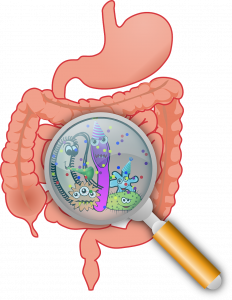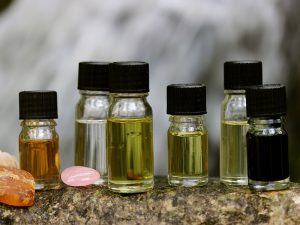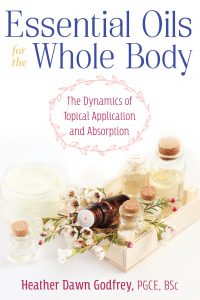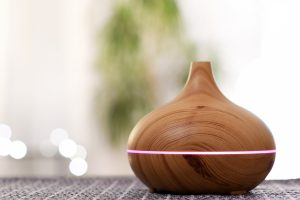- info@aromantique.co.uk
- 07419 777 451

Heather Dawn: Godfrey. P.G.C.E., B.Sc. (Joint Hon)
The article below includes excerpts from my new book, Healing with Essential Oils, published by Inner Traditions, Vermont USA
The human micro biome consists of trillions of microbes, including bacteria and fungi, which symbiotically live in and on the body – on the skin, in the gut, and in cavities such as the mouth, ears and vagina. The micro biome plays a significant role in protecting and maintaining immunity, and aids a number of vital bodily functions: for example, assisting the breakdown and synthesis of nutrients in the gut and aiding their appropriate absorption, and providing a protective barrier against invasion or proliferation of harmful microbes and pathogens. We coexist with microorganisms; our body houses, feeds, and depends on their presence to maintain functional equilibrium. Poor diet, sugary refined foods, overuse of antibiotics and pharmaceutical drugs, stress, and illness, among other factors, can disrupt the harmonious balance of the micro biome, and increase our susceptibility to pathogenic invasion. (Essential Oils for the Whole Body 2019 p 70)
So, our first, long-lasting, line of defence, when considering immunity, is to support our micro biome (and thus also our health and vitality through increased opportunity of optimum nourishment – ease of absorption and assimilation of vital nutrients): eat nutritionally rich, fresh,  seasonal, unrefined, organic whole foods, especially green vegetables, fruits, nuts, beans and other legumes, herbs and spices, fermented foods, and so on; drink plenty of water to hydrate and oxygenate cells, and flush out waste material from the system; also, fresh air, sunlight (photochemical formation of vitamin D), walking (movement and motion) and gentle exercise (to stimulate peristalsis in the gut, stimulate the lymphatic system, and remove waste products efficiently from the body). A plants micro biome can feed the body’s micro biome too, so leave the skin on organic vegetables and fruits, and eat these raw or just lightly cooked. EMF’s (electromagnetic fields) also disrupt the micro biome, so limit exposure to these as much as possible (turn off computers, mobile phones, and other remote signalling devices when not in use).
seasonal, unrefined, organic whole foods, especially green vegetables, fruits, nuts, beans and other legumes, herbs and spices, fermented foods, and so on; drink plenty of water to hydrate and oxygenate cells, and flush out waste material from the system; also, fresh air, sunlight (photochemical formation of vitamin D), walking (movement and motion) and gentle exercise (to stimulate peristalsis in the gut, stimulate the lymphatic system, and remove waste products efficiently from the body). A plants micro biome can feed the body’s micro biome too, so leave the skin on organic vegetables and fruits, and eat these raw or just lightly cooked. EMF’s (electromagnetic fields) also disrupt the micro biome, so limit exposure to these as much as possible (turn off computers, mobile phones, and other remote signalling devices when not in use).
 Essential oils to support the immune system
Essential oils to support the immune system
Essential oils are (with varying degrees of strength) anti-microbial, anti-fungal, anti-inflammatory, and mucolyptic. They also aid tissue regeneration.
Daily exposure to microbes enables the body to develop natural immunity. Remedies can be appropriately applied if and when required. Essential oil components number from a few to several hundreds – many are present in minute quantities, a few are present in large quantity. Their composition is complex. This means antimicrobial resistance to essential oils is potentially less likely than for conventional antibiotics; although, this cannot be taken for granted. See here for more information about applying essential oils safely, and using essential oils generally.
Essential oils are also very effective, even when applied in very small amounts, for psycho-emotional conditions (low mood, anxiousness, brain fog, etc.), for minor infections (coughs, colds, insect bites) and for skin conditions (cuts, grazes, eczema, dry skin, etc.).
For acute, potentially infectious conditions, severe cases of influenza, or other viral conditions, or for conditions you are unsure of, seek medical advice.
Powerful to moderate anti-microbial essential oils are listed below. Many of these essential oils are irritant and sensitising to the skin, mucous membrane and airways, especially when they are directly inhaled, even in small quantity, so apply them with careful consideration and in moderation.
All essential oils are highly concentrated volatile phyto-chemicals and, by their very nature, exhibit propensity to cause irritation, sensitisation, and sometimes an allergic reaction, especially if they are applied in large amounts, are over-used, or otherwise inappropriately applied.
Please note:
For comprehensive information about the safe and effective application of essential oils, how to blend them together, and much more, please refer to my book:

Meanwhile………
Click here for information about appropriate application of essential oils
Click here for information about measuring essential oils for personal use
Click here for information about methods of use
 High quantity of essential oil is required to fumigate an environment (at least 30 drops – this will depend on the size of a room or space). To fumigate a room efficiently, close all doors and windows to contain the essential oil vapours, and diffuse essential oils into the atmosphere for 30 minutes. Leave the room during fumigation. Once fumigation is complete, open windows and doors to allow inflow of fresh air to clear residue vapours.
High quantity of essential oil is required to fumigate an environment (at least 30 drops – this will depend on the size of a room or space). To fumigate a room efficiently, close all doors and windows to contain the essential oil vapours, and diffuse essential oils into the atmosphere for 30 minutes. Leave the room during fumigation. Once fumigation is complete, open windows and doors to allow inflow of fresh air to clear residue vapours.
Herbs, such as sage, rosemary, and juniper can be used instead of essential oils – these are usually ‘smoked or smudged’, that is, smouldered, to cleanse the atmosphere.
Add up to 15 to 20 drops of essential oil to hand sanitisers (non-perfumed liquid soap dispensers). Do not add essential oils to antibacterial sanitisers or pre-scented sanitisers (it is not necessary and may cause an irritant reaction). Soap, itself, is antibacterial – soap and water (careful hand washing and drying) is usually sufficiently effective.
 Essential oils with anti-microbial properties
Essential oils with anti-microbial properties
Please note that some of the essential oils listed below are strong irritants and sensitisers. Always check and reference the properties, qualities and contra indications of an essential oil before you apply it.
Examples of single essential oils with strong to medium anti-microbial properties
Cinnamon leaf and bark
Citronella
Clove bud
Eucalyptus blue gum and globulus
Geranium
Lavender
Lemon
Lemongrass
Pine
Tea tree
Thyme red
2-3 drops on a tissue and inhaled, 2-4 drops in steam inhalation, 2-4 drops in 10ml of carrier medium (vegetable oil, non-perfumed, lotion, cream, or aqueous gel) – do not use these blends in bath.
Click here for further instructions about methods of use
and
Click here for more detail about safe and appropriate application refer to my book (available at most book outlets) “Essential Oils for the Whole Body”
In addition to their antibiotic effects, oils react to a change of locality. From a distance this phenomenon seems to us to be the most important one, for, by changing the ecological condition which made possible the development and pathogenic growth of the germs, the oils stand in the way of their survival by preventing the body from building up resistances or adapting to the attacking agent. Better still, they protect against the return of the germs, both in the short and long term.
Dr Jean Valnet, 1980, The Practice of Aromatherapy, p47
Surely this is the key factor; the antiseptic power of essences does not diminish nor become blunted with the passing of time. Why not? it is hard to find a satisfactory answer, but perhaps it is because these natural substances, besides jugulating infections, reinforce the organism’s own defence mechanisms. They are in fact powerful alternatives. Furthermore, the organism does not appear to become accustomed to aromatherapy in the way that it does to synthetic sleeping pills, for instance, or – in the case of both body and germs – to the many forms of treatment using antibiotics.
Dr Jean Valnet, 1980, The Practice of Aromatherapy, p 45
References